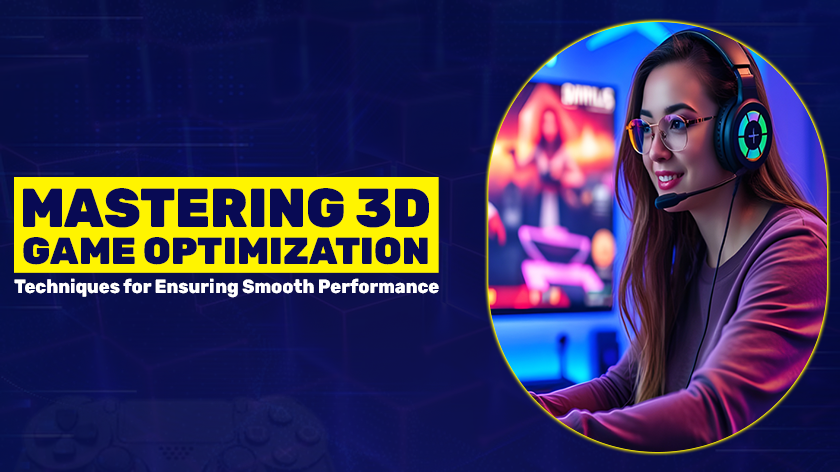As the demand for immersive 3D gaming experiences rises, ensuring smooth performance has become essential for delivering seamless and enjoyable gameplay. Optimizing a 3D game, however, involves more than just stunning visuals; it requires meticulous attention to technical aspects to maintain high frame rates, reduce loading times, and guarantee fluid interactions throughout the game.
In this blog, we’ll explore essential 3D game optimization techniques every developer should know to achieve the best possible performance.
1. Optimize 3D Assets
One of the first steps to improving game performance is optimizing 3D assets. High-quality models and textures can significantly increase the demand for system resources, slowing down the game. To avoid this, developers should focus on reducing the polygon count for models and using texture compression techniques.
Best practices for asset optimization include:
- Level of Detail (LOD): Use different LOD versions of models, displaying high-poly models only when necessary (e.g., when close to the camera) and switching to models when they’re farther away.
- Texture Atlases: Reducing the number of texture swaps can speed up rendering by combining small images into a single texture vector.
- Efficient UV Mapping: Optimize UV maps to ensure textures fit more efficiently, minimizing wasted space and memory usage.
Impact: reduced resource consumption and faster rendering times, leading to smoother gameplay.
2. Optimize Lighting and Shading
Lighting is a critical aspect of 3D games but can also be a major performance bottleneck. Complex lighting systems and shadows often require significant computational power. Optimizing these elements can help maintain high frame rates without compromising visual quality.
Key techniques include:
- Baking Lighting: Pre-compute lighting for static objects, reducing the need for real-time lighting calculations.
- Lightmap Usage: Use lightmaps for static lighting, which involves storing lighting information in textures, eliminating the need for dynamic lighting updates.
- Efficient Shadow Rendering: Use techniques like cascaded shadow maps to render detailed shadows close to the player while simplifying shadow rendering for distant objects.
Impact: Enhanced lighting effects with minimal performance costs.
3. Reduce Draw Calls
The number of times the CPU and GPU interact to produce images on the screen is known as the draw calls. Efficiency can be seriously compromised by excessive draw calls, particularly in large 3D models. Improving the game requires lowering draw calls.
Optimization tips:
- Batching: Combine objects that share the same material into a single draw call to minimize the number of calls sent to the GPU.
- Instancing: Use instancing to render multiple copies of the same object with a single draw call, particularly useful for objects like trees or buildings in a game environment.
- Frustum Culling: Implement frustum culling to avoid rendering objects that are outside the player’s field of view.
Impact: Lower draw calls reduce CPU-GPU communication, resulting in improved frame rates.
4. Optimize Physics Calculations
In 3D games, physics simulations can add realism but also put a strain on system resources if not managed properly. Developers need to optimize physics interactions to avoid excessive CPU usage.
Optimization methods include:
- Simplified Collision Models: Use low-poly or primitive shapes (e.g., boxes, spheres) for collision detection rather than detailed 3D models.
- Physics LOD: Use simplified physics calculations for distant or less important objects and more detailed simulations for nearby or critical objects.
- Optimize Rigid Body Calculations: Limit the number of rigid body calculations by only enabling physics interactions when necessary (e.g., when the player is near the object).
Impact: More efficient physics simulations, resulting in smoother gameplay without sacrificing realism.
5. Optimize Memory Usage
Efficient memory management is crucial for avoiding performance issues like stuttering, lag, and crashes in 3D games. Large assets and complex game states can quickly consume memory, leading to slowdowns.
Memory optimization techniques:
- Object Pooling: Reuse frequently used objects instead of creating and destroying them repeatedly. This reduces memory allocation and improves performance.
- Texture Streaming: Load textures as needed, especially for large open-world games. Texture streaming allows the game to load lower-resolution textures for distant objects and higher-resolution textures as they come closer to the player.
- Garbage Collection: Manage memory efficiently by avoiding frequent memory allocations that trigger garbage collection, which can cause performance hiccups.
Impact: Lower memory usage results in smoother game performance, especially on devices with limited resources.
6. Frame Rate Optimization
A smooth and consistent frame rate is key to a good gaming experience. Optimizing frame rates involves ensuring that your game maintains a stable performance level across different devices, especially on lower-end hardware.
Frame rate optimization strategies:
- V-Sync: Synchronize the game’s frame rate with the display’s refresh rate to avoid screen tearing.
- Frame Rate Capping: Limit the maximum frame rate to prevent the game from rendering more frames than the device can handle, reducing strain on the GPU.
- Dynamic Resolution Scaling: Adjust the game’s resolution dynamically based on the available resources, ensuring a stable frame rate even in resource-intensive scenes.
Impact: Consistent and smooth gameplay without frame drops or tearing, improving overall user satisfaction.
Conclusion: Achieving Smooth 3D Game Performance
Optimizing 3D games for smooth performance requires attention to various aspects, from asset and lighting optimization to reducing draw calls and managing memory. By implementing these techniques, developers can ensure that their 3D games run smoothly, offering players an immersive and enjoyable experience across a wide range of devices.
Need help optimizing your 3D game for peak performance? Contact us today to bring your game to the next level with expert optimization techniques that ensure a flawless gaming experience.
For more information: https://www.xceltec.com/
 :
https://in.pinterest.com/xceltec0192/
:
https://in.pinterest.com/xceltec0192/

